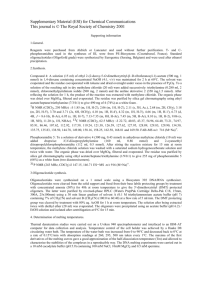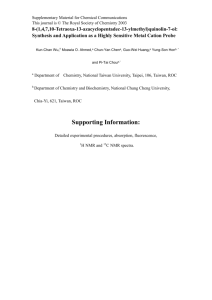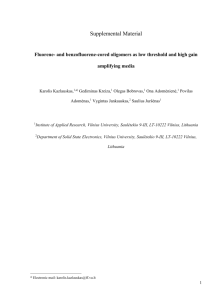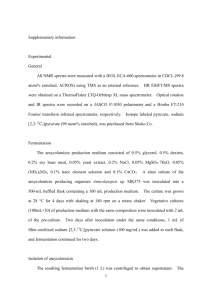solvent quantum
advertisement
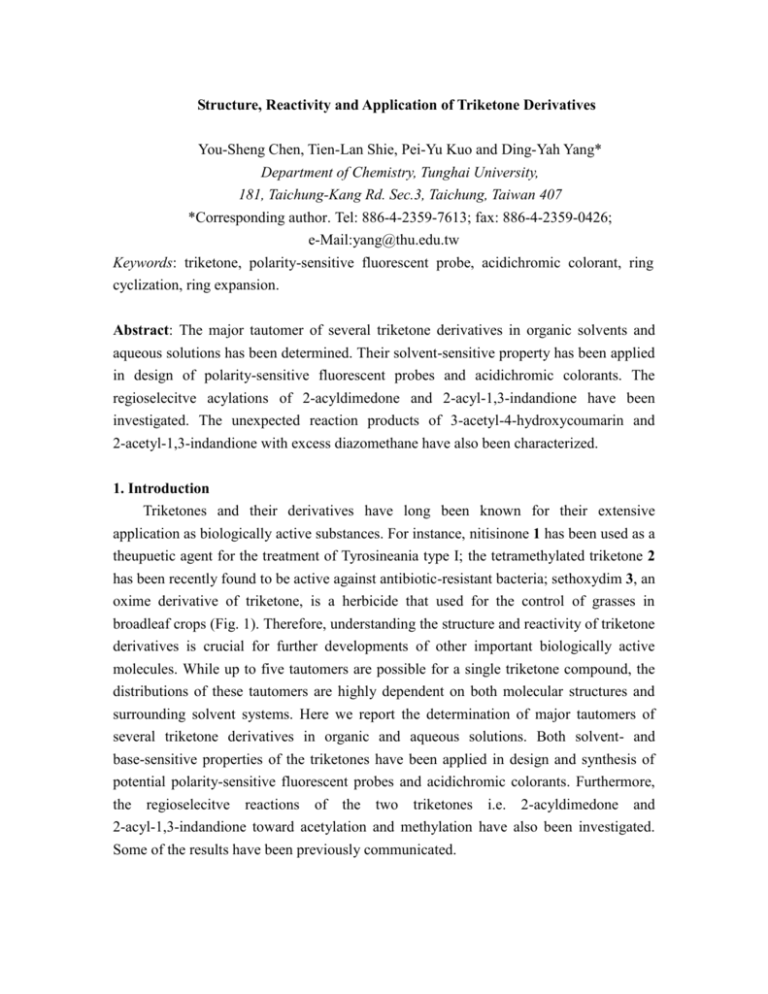
Structure, Reactivity and Application of Triketone Derivatives You-Sheng Chen, Tien-Lan Shie, Pei-Yu Kuo and Ding-Yah Yang* Department of Chemistry, Tunghai University, 181, Taichung-Kang Rd. Sec.3, Taichung, Taiwan 407 *Corresponding author. Tel: 886-4-2359-7613; fax: 886-4-2359-0426; e-Mail:yang@thu.edu.tw Keywords: triketone, polarity-sensitive fluorescent probe, acidichromic colorant, ring cyclization, ring expansion. Abstract: The major tautomer of several triketone derivatives in organic solvents and aqueous solutions has been determined. Their solvent-sensitive property has been applied in design of polarity-sensitive fluorescent probes and acidichromic colorants. The regioselecitve acylations of 2-acyldimedone and 2-acyl-1,3-indandione have been investigated. The unexpected reaction products of 3-acetyl-4-hydroxycoumarin and 2-acetyl-1,3-indandione with excess diazomethane have also been characterized. 1. Introduction Triketones and their derivatives have long been known for their extensive application as biologically active substances. For instance, nitisinone 1 has been used as a theupuetic agent for the treatment of Tyrosineania type I; the tetramethylated triketone 2 has been recently found to be active against antibiotic-resistant bacteria; sethoxydim 3, an oxime derivative of triketone, is a herbicide that used for the control of grasses in broadleaf crops (Fig. 1). Therefore, understanding the structure and reactivity of triketone derivatives is crucial for further developments of other important biologically active molecules. While up to five tautomers are possible for a single triketone compound, the distributions of these tautomers are highly dependent on both molecular structures and surrounding solvent systems. Here we report the determination of major tautomers of several triketone derivatives in organic and aqueous solutions. Both solvent- and base-sensitive properties of the triketones have been applied in design and synthesis of potential polarity-sensitive fluorescent probes and acidichromic colorants. Furthermore, the regioselecitve reactions of the two triketones i.e. 2-acyldimedone and 2-acyl-1,3-indandione toward acetylation and methylation have also been investigated. Some of the results have been previously communicated. 2. Results and Discussion Although previous study have demonstrated that both 2-acyldimedone and 2-acyl-4-hydroxycoumarin mainly exist in endocyclic enol forms in solid states, the major tautomer of these triketones present in solution is highly dependent on solvent polarity. For example, the major tautomer of 2-acetyldimedone in relatively nonpolar organic solvents such as hexane and chloroform is in the endocyclic enol form, and the major tautomer in polar protic solvents like methanol or aqueous solution mainly presents in the exocyclic enol form. A similar observation is also made of 2-acetyl-4-hydroxycoumarin, as indicated in Scheme 1. O OH O O O OH O O O O OH O O OH O O O O O O exocyclic enol dominant tautomer in H2O and MeOH keto O endocyclic enol dominant tautomer in CHCl3 and hexane Scheme 1. The major tautomer of 2-acetyldimedone and 2-acetyl-4-hydroxycoumarin exists in polar protic and nonpolar solutions. The solvent-sensitive property of 2-acetyl-4-hydroxycoumarin can be applied to design and synthesis of potential polarity-sensitive fluorescent molecules. Generally, a polarity-sensitive fluorescent molecule is weakly fluorescent in aqueous solution, but brightly fluorescent when dissolved in nonpolar organic solvents. It may function as a probe to determine the solvent polarities empirically, and to evaluate “polarity” of protein and enzyme binding sites as well as to study the structure of binding sites and dynamics of lipid layers/natural membranes on a molecular level. Since 2-acetyl -4-hydroxycoumarin is weakly fluorescent, an N,N-dimethylamino group was incorporated on the 7-position of the coumarin moiety in an effort to enhance its fluorescence property. The proposed compound 7 was prepared in four steps as outlined in Scheme 2. It started with esterification of malonic acid with phenol in the presence of phosphorus oxychloride to give the diester 4. The diester was then coupled with 3-N,N-dimethylaminophenol in toluene to afford coumarin 5. Esterification of 5 with acetyl chloride in the presence of triethylamine as a base yielded ester 6. Final isomerization was achieved by treating 6 with a catalytic amount of potassium cyanide in methylene chloride to afford the target molecule 7. The results indicated that compound 7 exists mainly in the endocyclic enol form in organic solvents like methylene chloride and is highly fluorescent due to the presence of N,N-dimethylamino group. Essentially no fluorescence is detected when 7 was dissolved in protic solvents like methanol, where 7 exists mainly in the exocyclic enol form (Scheme 3). Figure 1 shows the UV absoprtioin spectra of 7 in various compositions of methanol and methylene chloride. Two isosbestic points were observed at 300 and 350 nm, which suggest interconversion of different tautomeric forms of 7. The fluorescence quantum yield of 7 in various solvents was also determined as indicated in Table 1. Up to 30 times difference between the highest fluorescence quantum yield of 7 in benzene (f = 0.91) and the lowest fluorescence quantum yield in water (f= 0.03). OH O HO O O i OH O PhO ii OPh N 4 O O 5 iii O O OH O iv N O 7 O N O O 6 Scheme 2. Reagents and conditions: (i) POCl3, phenol, 115 oC, 1.5 h; (ii) 3-(dimethylamino)phenol, toluene, reflux, 7h; (iii) acetyl chloride, Et3N, CH2Cl2, 0 oC, 0.5 h; (iv) KCN, Et3N, 18-crown-6, CH2Cl2, rt, 72 h. OH O N O O Dichloromethane Strong fluorescence N O OH O O Methanol Weak fluorescence Scheme 3. Fluorescence difference of 7 in CH2Cl2 and CH3OH. Figure 1. UV absoprtioin spectra of 7 in various compositions of methanol and methylene chloride. Table 1. The fluorescence quantum yield of 7 in various solvents. Solvent ex (nm) em (nm) Quantum yield (f) benzene hexane toluene CH2Cl2 CHCl3 EtOAC THF 385 375 385 385 385 385 385 407 384 405 418 414 418 420 0.91 0.90 0.86 0.85 0.82 0.41 0.31 acetone EtOH CH3CN CH3OH DMF H2O 385 385 385 345 389 345 429 424 433 421 418 427 0.04 0.04 0.03 0.03 0.03 0.03 Since the energy difference between exocyclic and endocyclic enols of 2-acetyl-4-hydroxycoumarin has been calculated to be only one kcal/mol,* we speculated that major tautomer of 2-acyldimedone in nonpolar organic solutions can be reversed from the endocyclic enol form to the exocyclic enol tautomer by a simple conjugation extension. The extension of conjugation can be easily accomplished by based catalyzed condensation of 2-acetyldimedone with 4-N,N-dimethylaminobenzaldehyde to yield the compound 8 (Scheme 4). The observation of a long range coupling with a coupling constant of 0.9 hertz between the enolic hydrogen and the adjacent vinyl hydrogen on proton NMR spectrum in deuterated chloroform confirmed that 8 exists in the more conjugated exocyclic enol form in nonpolar organic solvents. This result suggested that the major tautomer of the triketone derivatives can be easily shifted from one to the other by introducing an extra functional group adjacent to it. Notably, the resulting compound 8 is no longer polarity-sensitive and exists as a single tautomer. Similar extension of conjugation of 2-acetyl-4-hydroxycoumarin also switched the major tautomer to the expected exocyclic enol 9. O O O H O i O O N 8 O OH O H O i O O O O N 9 Scheme 4. Shifting the endocyclic enol tautomer to exocyclic enol tautomer by extension of conjugation. Reagents and conditions: (i) 4-Dimethylaminobenzaldehyde, NaOH, MeOH, 80 oC, 24 h. In addition to be polarity-sensitive, the structures of the triketones are also sensitive to the presence of bases. For instance, the triketone functional group in 2-acyl-1,3-cyclohexanedione is coplanar,11 owing to the conjugation of C-2 carbonyl moiety with the cyclohexene ring system by an intramolecular hydrogen bond of the C-3 hydroxyl hydrogen to the oxygen atom of C-2 carbonyl group. After deprotonation of C-3 hydroxyl group by a base, however, the intramolecular hydrogen bond is disrupted. The subsequent intrinsic electrostatic repulsion between the 2-acyl oxygen atom and the two 1,3-diketone oxygens causes deformation of the molecule from planarity. This base-sensitive property of triketones has been recently applied to design and synthesis of an acidichromic colorant (Scheme 5).* Na O H O O H O O O colorless H N Cl NaH O NaH HCl(g) O red N HCl(g) O yellow N Scheme 5. The acidichromic switch of 8 and the corresponding colors in acidic, neutral, and basic conditions. In the case of 2-acyl-1,3-indandione, three tautomers are also possible for this benzene fused triketone (Scheme 6). The crystal structure of 2-actyl-1,3-indandione* has been determined to be in the exocyclic enol form in the solid state, with the enolic hydrogen external to the indan system, thus the indan portion is essentially planar. This exocyclic enol form is also the major tautomer in solutions and is not solvent-sensitive. The reason why this particular configuration is favored over the other possible endocyclic enol tautomer is currently not clear, presumably due to the antiaromatic nature of the later.* OH O O O exocyclic enol O O OH O keto O endocyclic enol major tautomer Scheme 6. Three possible tautomers of 2-acetyl-1,3-indandione. Acetylation of 2-acetyl-1,3-cyclohexadione with acetyl chloride under basic conditions reacts specifically at 3-enolic oxygen to give the enol ester 10. The electrostatic repulsion between the 2-acyl oxygen atom and the two 1,3-diketone oxygens of the resulting enol ester caused deformation of the triketone functional group from planarity. This repulsion can be easily relieved via enolization of the 2-acyl group and followed by a 1,5-acyl transfer reaction. Thus, with available -hydrogens on the 2-acyl group, this intrinsic repulsion presumably provides a driving force for enol ester 10 to undergo enolization and subsequent isomerization. A similar rearrangement was also observed for 3-acyl-4-hydroxycoumarin, as shown in Scheme 7. O O OH O O OH O O O O i O O O 11 O 10 O O O OH O O OH O O O O O i O O O O O O 12 O O 13 O O Scheme 7. Acetylation and subsequent 1,5-acyl transfer reaction of 2-acetyl-1,3-cyclohexadione and 3-acetyl-4-hydroxycoumarin. Reagents and conditions: (i) acetyl chloride, Et3N, CH2Cl2, rt. Acetylation of 2-acyl-1,3-indandione, however, reacted selectively at C-2 hydroxy group to give the product 14 quantitatively. Although the methyl enol ether 14 is relatively unstable due to the previously mentioned electrostatic repulsion between the two oxygens and is easily hydrolyzed in aqueous solution, it is more stable than 15 which is methylated at endocyclic enolic oxygen and is further destabilized by the proposed antiaromatic nature. No further rearrangement of 14 was observed. O O O O O OH O i O 14 O O + O 15 not observed Scheme 8. Acetylation of 2-acetyl-1,3-indandione. Reagents and conditions: (i) acetyl chloride, Et3N, CH2Cl2, rt. Similar to acylation, alkylation of 3-acyl-4-hydroxycoumarin has also been found to react specifically at endocyclic enolic oxygen to give the corresponding enol ether, while alkylation of 2-acyl-1,3-indanedione reacted at exocyclic enolic oxygen, as shown in Scheme 9. Reaction of 3-acetyl-4-hydroxycoumarin with excess diazomethane in methylene chloride, however, generated the methylated compound 16 and the unexpected ring cyclization product 17 with 1:1 ratio. Interestingly, reaction of 2-acetyl-1,3-indanedione also gave the unexpected ring expansion product 19, in addition to methyl enol ether 18. The mechanisms for the formation of ring cyclization and expansion products are proposed in Schemes 10 and 11, respectively. The favored stabilization energy obtained after aromatization seems to be the major driving force for both reactions. OMe O OH O O i O + O O O 17 16 OH O O O OH O O OCH3 i + O O OCH3 19 18 Scheme 9. Reagents and conditions: (i) CH2N2, CH2Cl2, 0 oC. N H OH O N O O CH2N2 O O O O O OH -N2 O O -H2O O O Scheme 10. O OH O OH O OH O CH2N2 -N2 O ON OH O OH O O OH O N O OH CH2N2 OCH3 Scheme 11. 3. Conclusions The solvent-sensitive and base-sensitive properties of the triketones have been successfully applied in design and synthesis of a polarity-sensitive fluorescent probe and an acidichromic colorant, respectively. Additionally, the major endocyclic enol tautomer of the triketone derivatives in organic solvents can be switched to the exocyclic enol form by extension of the conjugation. Moreover, acylations of 2-acyl-1,3-dimedone and 2-acyl-4-hydroxycoumarin were found to react specifically at endocyclic enolic oxygen and follow by a subsequent 1,5-acyl transfer reaction, while acylation of 2-acyl-1,3-indandione reacted at exocyclic enol hydrogen to give the corresponding enol ester without further rearrangement. Finally, reactions of 3-acetyl-4-hydroxycoumarin and 2-acetyl-1,3-indandione with excess diazomethane resulted in unexpected ring cyclization and expansion products. 4. Experimental 4.1 General procedures Melting points were determined on a Mel-Temp melting point apparatus in open capillaries and are uncor-rected. 1H and 13C NMR spectra were recorded at 300 and 75 MHz on a Varian VXR300 spectrometer. Chemical shifts were reported in parts per million on the scale relative to an internal standard (tetramethylsilane, or appropriate solvent peaks) with coupling constants given in hertz. 1H NMR multiplicity data are denoted by s (singlet), d (doublet), t (triplet), q (quartet), and m (multiplet). Analytical thin-layer chromatography (TLC) was carried out on Merck silica gel 60G-254 plates (25 mm) and developed with the solvents mentioned. Flash chromatography was performed in columns of various diameters with Merck silica gel (230-400 mesh ASTM 9385 kieselgel 60H) by elution with the solvent systems. Solvents, unless otherwise specified, were reagent grade and distilled once prior to use. All new compounds exhibited satisfactory spectroscopic and analytical data. 4.1.1. Diphenyl 2-ethylidenemalonate (4).1 To a mixture of malonic acid 5 (11.0 g, 106 mmol) and phenol (20.0 g, 212 mmol) was slowly added at 0 °C POCl3 (11.5 mL, 123 mmol). The mixture was heated at 115 °C until strong release of HCl ceased (about 1.5 h). The upper layer was poured into 150 mL of water and three extractions with ether followed by the usual workup gave diphenyl malonate 6 (26.6 g, 98%) as a pale brown solid which was pure enough to be used without further purification in the next step. An analytical sample of 6 was obtained by recrystallization from a mixture of ether/ pentane: mp 51 °C (ether/pentane) (lit.15 mp 50 °C (EtOH/H2O)); EIMS m/z (rel int) 256 (M+, 2), 95 (12), 94 (base), 77(18), 65 (13); IR (Nujol) 1746, 1731 cm-1; 1H NMR (CDCl3) 3.95 (s, 2H), 7.10-7.50 (m, 10H); 13C NMR (CDCl3) 41.81,121.5 (4C), 126.5 (2C), 129.7 (4C), 150.5 (2C), 164.9 (2C). 4.1.2. 7-(Dimethylamino)-4-hydroxycourmarin (5). To a solution of compound 11 (3.5 g, 13.6 mmol) in toluene (20 mL) was added 3-(dimethylamino)phenol (1.9 g, 13.6 mmol). The reaction mixture was heated to reflux for 7 h. After completion of the reaction (monitored by TLC) and then filtered. The cake was washed with hexanes and then dried under vacuum to give a gray solid in a 85% yield. Mp 251-252 oC.2 1H NMR (CDCl3, 300 MHz) 7.55 (d, J=8.7 Hz, 1H), 6.68 (dd, J=8.7, 2.4 Hz, 1H), 6.48 (d, J=2.4 Hz, 1H), 5.27 (s, 1H), 2.99 (s, 6H). 4.1.3. 7-(Dimethylamino)-2-oxo-2H-chromen-4-yl acetae (6). To a stirred mixture of 7-(dimethylamino)-4-hydroxycourmarin (1.0 g, 4.9 mmol) and triethylamine (0.5 g, 4.9 mmol) in methylene chloride (20 mL) was added acetyl chloride (0.38 g, 4.9 mmol) at 0 o C for 30 min. After completion of the reaction, water (5 mL) was added to the mixture and the product was extracted twice with methylene chloride. The combined organic extracts were dried over MgSO4, filtered, concentrated. The resulting crude product was purified by column chromatography (1:9 EtOAc/hexanes) to give red solid in a 80% yield. Mp 110-111 oC. 1H NMR (CDCl3, 300 MHz) 7.35 (d, J= 9.0 Hz, 1H), 6.57 (dd, J= 9.0, 2.4 Hz, 1H), 6.43 (d, J= 2.4 Hz, 1H), 6.08 (s, 1H), 3.03 (s, 6H), 2.40 (s, 3H). 13C NMR (CDCl3, 75 MHz) 166.6, 162.6, 159.4, 155.7, 153.3, 123.2, 108.8, 103.9, 99.0, 97.6, 77.4, 77.0, 76.6, 40.0, 21.1; IR: 3090.43, 1600.66, 895.08, 813.66. HRMS (EI) m/z calcd for C15H15NO4 273.1001, found 273.1005 (M+). 4.1.4. 3-Acetyl-7-(dimethylamino)-4-hydroxy-2H-chromen-2-one (7). To a solution of compound 6 (0.64 g, 2.6 mmol), KCN (0.2 g, 2.6 mmol) in methylene chloride (10 mL) was added triethylamine (0.3 g, 2.6 mmol) and a catalytic amount of 18-crown-6. After the mixture was stirred for 3 days at room temperature, water (5 mL) was added to the mixture and the product was extracted twice with methylene chloride. The combined organic extracts were dried over MgSO4, filtered, concentrated. The resulting crude product was purified by column chromatography (1:6 EtOAc/hexanes) to give a red solid in a 90% yield. Mp 169-170 o C. 1H NMR (CDCl3, 300 MHz) 17.64 (s, 1H), 7.82 (d, J= 9.3 Hz, 1H), 6.63 (dd, J= 9.3, 2.4 Hz, 1H), 6.37 (d, J= 2.4 Hz, 1H), 3.12 (s, 6H), 2.72(s, 3H)). 13C NMR (CDCl3, 75 MHz) 204.4, 177.9, 161.1, 157.0, 155.7, 126.7, 109.2, 103.2, 98.6, 96.8, 77.4, 77.0, 76.6, 40.125, 29.8. HRMS (EI) m/z calcd for C15H15NO4247.8853, found 247.0853 (M+). IR: 3359.9, 1726.21, 1621.21, 1426.79, 823.55, 770.23. 4. 2. General procedure for preparation of compounds a-b. To a solution of 2-acetyl-3-hydroxycyclohex-2-enone (0.65 mmol) and triethyiamine (177 mg, 1.75 mmole) in methylene chloride (5 mL) was added acetyl chloride (127 mg, 1.62 mmole) at 0 o C. After the mixture was stirred for 3 days at room temperature, water (5 mL) was added to the mixture and the product was extracted twice with methylene chloride. The combined organic extracts were dried over MgSO4, filtered, concentrated. The resulting crude product was purified by column chromatography to give the desired product. 4. 2. 1. Acetic acid 2-(1-acetoxy-vinyl)-3-oxo-cyclohex-1-enyl ester (a). Yield 80%. 1H NMR (CDCl3, 300 MHz) 7.38 (d, J=9.0 Hz, 1H), 6.59 (dd, J=9.0, 2.4 Hz, 1H), 6.46 (d, J=2.4 Hz, 1H), 6.09 (s, 1H), 3.0 (s, 6H), 1.93 (tt, J=8.1, 4.5 Hz, 1H), 1.27-1.21 (m, 2H), 1.18-1.10 (m, 2H). 4. 2. 2. Acetic acid 1-(4-hydroxy-2-oxo-2H-1-benzopyran-3-yl)vinyl ester (b). Yield 83%. Mp 109-110 o C. 1H NMR (CDCl3, 300 MHz) 7.38 (ddd, J=9.0 Hz, 1H), 7.48 (dd, J=7.8, 1.2 Hz, 1H), 7.36-7.28 (m, 2H), 5.42 (d, J=4.8 Hz, 1H), 5.41 (d, J=4.8 Hz, 1H), 2.45 (s, 3H), 2.16 (s, 3H). 13C NMR (CDCl3, 75 MHz) 168.2, 166.6, 159.3, 156.0, 152.5, 143.1, 133.0, 124.5, 123.4, 116.7, 115.6, 114.6, 110.6, 20.6. 4. 2. 3. 1-(1,3-dioxo-1H-inden-2(3H)-ylidene)ethyl acetate (14). Yield 90%. Mp 94-95 o C. 4. 3. General procedure for preparation of compounds 16-19. To a solution of acetyl-1,3-indanedione (500 mg, 2.7 mmol) in dichloromethane (5 mL ) was added excess diazomethane at 0 o C. After completion of the reaction (monitored by TLC), the solution was evaporated. The resulting crude product was purified by column chromatography to give the desired product. 4. 3. 1. 3-acetyl-4-methoxy-2H-chromen-2-one (16). Yield 45%. 4. 3. 2. 3-methyl-4H-furo[3,2-c]chromen-4-one (17) 4. 3. 3. 2-(1-methoxyethylidene)-2H-indene-1,3-dione (18) Yield 50%. 1H NMR (CDCl3, 300 MHz) 7.44-7.21 (m, 4H, ArH), 4.19 (s, 3H, OCH3), 2.22 (s, 3H, CH3). 4. 3. 4. 1-(1-hydroxy-4-methoxynaphthalen-2-yl)ethanone (19). Yield 50%. 4. 4. UV and fluorescence measurements Absorption spectra were acquired using a Hitachi U-4000 spectrophotometer and emission spectra were obtained on a Hitachi F-4500 fluorospectrometer. Absorption and fluorescence spectra of gels were measured with a sample gel sandwiched by two quartz plates, one of which had 1 mm concavity. 4. 5 Calculation of fluorscence quantum yield UV-vis spectra were measured on a HP8453 spectrometer with a 1 cm path length quartz cell.Fluorescence spectra were measured on a HITACHI F-4500 fluorescence spectrophotometer. Coumarin 1(Φf =0.99,λmax =374 nm in CH2Cl2) was used as a external standard for the measurement of fluorescence quantum yields of 4 . Fluorescence quantum yields were measured by comparing the integrated area under the fluorescence curve for the compound 4 and coumarin 1 at equal absorbance at the same excitation wavelength. All fluorescence spectra are uncorrected and the estimated error for the fluorescence quantum yields is 15%, although the quantum yields were corrected for the refractive index of the solvent. Acylations. Compounds were synthesized by the method described previously and the previously undescribed compounds are characterized below: Acknowledgements The authors would like to thank the National Science Council of Republic of China, Taiwan for financially supporting this research under Contract No. NSC 93-2113-M-029-002 References and notes 1. Jabin, I.; Revial, G.; Monnier-Benoit, N.; Netchitaı¨lo, P. J. Org. Chem. 2001, 66, 256-261. 2. Knierzinger, A.; Wolfbeis, Otto S.; JHTCAD; J. Heterocycl. Chem. 1980, 17, 225-229.

